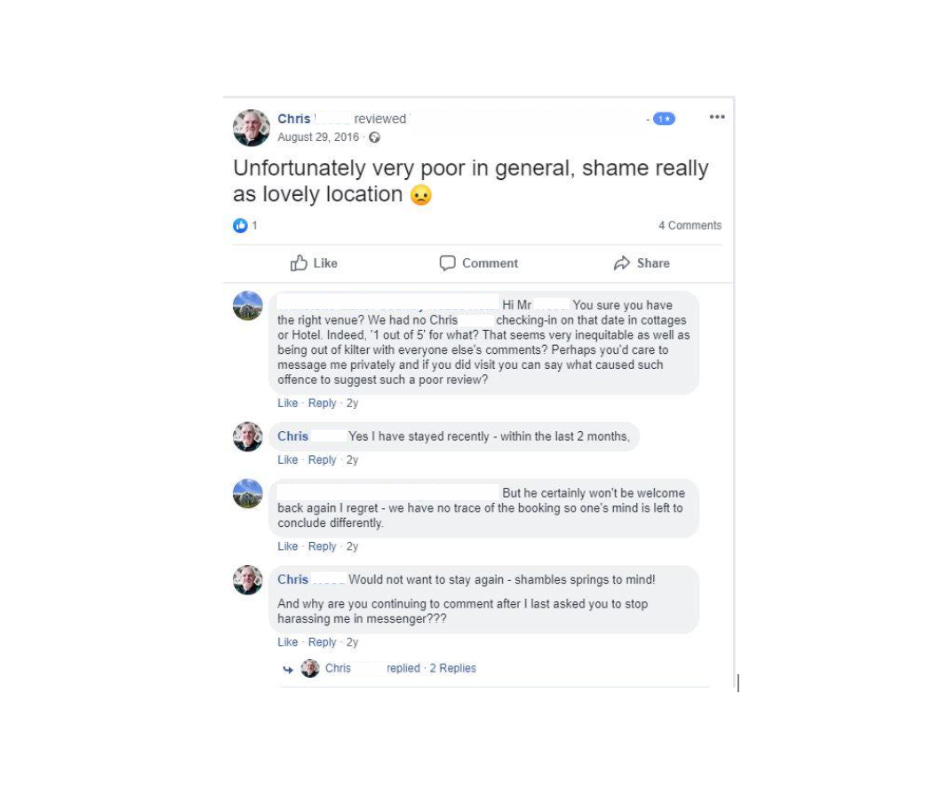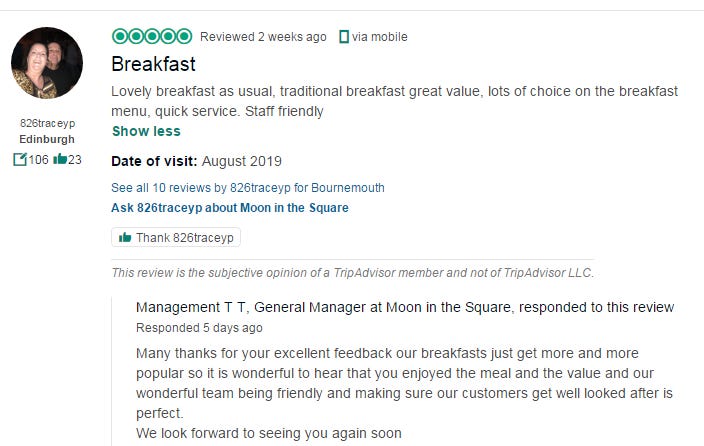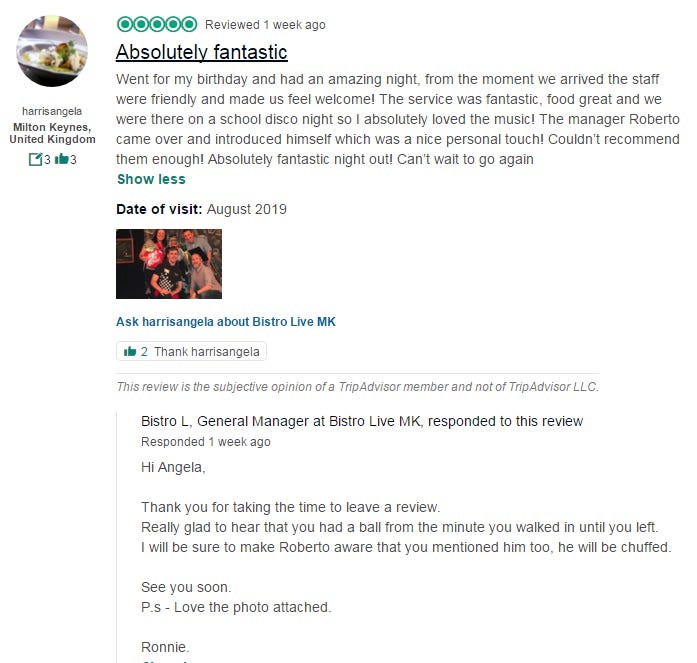📌 Handle Reviews Like a Pro With EASE and TIP
From fake reviews to five stars, here’s how to respond with confidence
It usually happens at the worst moment. Service is in full swing, the inbox is filling, and then a notification lands: a new review. Before you even click, your stomach tightens because one bad review on Google, TripAdvisor, or Facebook can undo weeks of hard work.
🌞 Hello and Welcome To Hospitality Marketing Insight
I’m your host, Dawn Gribble, and this week we’ll be taking a tactical approach to review management.
📄 On the Menu
Checking Review Validity
How to TIP Positive Reviews
How to Handle Negative Reviews with EASE
Mixed Feedback Management
Responding to Ratings
Let’s Check In ☕
For hospitality teams, reviews are more than opinions. They are public records that shape how future guests judge your brand before they have even walked through the door. In an age where AI search and social platforms increasingly prioritise reviews in rankings, every comment carries weight.
Managers and marketing or social media staff are usually the first to see reviews, and they need clear processes to follow. This ensures feedback is handled promptly, consistently, and in a way that turns risk into opportunity.
A poor review highlights gaps to close; a glowing one can be amplified to inspire your team and attract new guests. Both require the same discipline: empathy, speed, and professionalism.
👉 Forward this guide to your Front of House, Marketing, and Ops teams so everyone is aligned on how to handle reviews.
🔍 Checking the Validity of the Review
Not every review is genuine. Both restaurants and hotels have been targeted by fake reviews, whether from competitors, disgruntled staff, or coordinated campaigns. These can damage revenue, harm team morale, and influence future bookings. That is why the first step in any review process is to confirm whether the feedback is authentic.
Check the user
Have they been posting large numbers of negative comments?
Are they targeting similar businesses or brands?
Do they have links to competitors?
Is their profile incomplete, with no photo or personal details?
Check the content
Is the language vague or overly general?
Does it look copied and pasted?
Are the goods, services, or products referenced correctly?
If they mention timing (such as “we came in last night”), does it match your opening hours?
Most genuine reviews include specifics, such as dish names, room types, staff names, or prices. If the text is vague and the profile is incomplete, treat it with caution.
What to do next
If the reviewer has a track record of mixed reviews and a complete profile, they are likely genuine.
If they only post negative comments, provide no evidence they visited, and have a bare profile, it is likely fake.
If you are not sure, flag the review internally for a second opinion.
If the review is fake
Report it through the platform’s removal process and keep a screenshot for your records, including text, username, and date.
If the review is genuine
Treat it as real and escalate internally to agree on the resolution before replying.
👉 To make reviews more effective, I’ve created two proven frameworks in reputation management: EASE, to evaluate negative reviews and decide on the right course of action, and TIP, to structure responses to positive reviews.
🌟 TIP Positive Reviews
Positive reviews are more than compliments. AI search engines and social platforms prioritise user-generated content, serving as powerful signals of trust. A steady flow of positive feedback not only reassures future guests but also signals to algorithms that your business is trustworthy and relevant. In short, every positive review is both free marketing and a competitive edge.
The TIP framework helps you make the most of them:
Thank – Thank the customer for getting in touch. Show genuine appreciation for their time and feedback, and acknowledge their specific experience.
Invite – Invite them to share more details about what they enjoyed or encourage them to return. This deepens engagement and keeps the conversation alive.
Personalise – Where possible, personalise with their name and reference the details in their review. This proves you read their feedback carefully and that their words matter.
Examples
⭐⭐️⭐️⭐️⭐️: “Had a wonderful stay, staff were friendly and the breakfast was excellent.”
Response: Thank you, Sarah. We are delighted you enjoyed your stay with us and especially our breakfast service. We will be sure to share your kind words with the team. We look forward to welcoming you back soon.⭐⭐️⭐️⭐️ “Best pizza in town, loved the truffle topping!”
Response: Thank you for your generous feedback. We are so pleased you enjoyed the truffle pizza. It is a favourite with our team too. Next time you visit, we would love to recommend a few of our other specialities.⭐⭐️⭐️⭐️⭐️ “The room was spotless and the staff went above and beyond.”
Response: Thank you, James. Cleanliness and service are two things we take great pride in, and it means a lot that you noticed. We hope to welcome you back again soon.
Positive reviews are marketing fuel: amplify them by sharing on your socials.
👉 By responding thoughtfully to positive reviews, you are not only strengthening relationships with existing guests but also influencing every potential guest who reads them.
For negative reviews, the approach is different, but just as structured. This is where the EASE framework comes in.
🛠️ Handle Negative Reviews with EASE
A single negative review can feel like a punch in the gut. It is natural to take criticism personally, especially when you and your team have worked hard to deliver great service. But reacting in the heat of the moment rarely helps. Having a structured process makes it easier to stay calm, respond professionally, and even turn complaints into opportunities for loyalty and learning.
That is what the EASE framework is designed for. It provides a way to take control of the situation, protect your brand, and transform negative feedback into actionable insights that enhance service and strengthen trust.
Empathise – Recognise that mood and context play a role in how guests respond. A bad day or small disappointment can colour their whole experience. Approach the situation with patience and a willingness to understand their perspective.
Acknowledge – Show that you have heard them. On public platforms, post a short reply apologising and making it clear you will reach out privately. This reassures the reviewer that their concern matters and signals to others that you take feedback seriously.
Solve – Address the issue directly. Share the resolution privately with the guest and, where appropriate, note publicly that steps have been taken. This can turn a critic into a loyal guest and demonstrates accountability to potential customers.
Evaluate – Go beyond the single incident. Ask what went wrong, why it happened, and what needs to change to prevent a repeat. Use reviews to trigger team training, update processes, and strengthen your service standards.
Encourage your team to use this framework so that reviews are handled consistently, even when you are unavailable.
Examples
⭐: “Our booking was lost, and we waited an hour before being checked-in.”
Response: We are very sorry for the delay and the mix-up with your booking. We have contacted you privately to arrange a refund and offer an upgrade or complimentary night on a future stay as an apology. We have also introduced a new double-check procedure at the reservations desk to prevent this happening again.
⭐⭐: “The food was fine, but our server seemed distracted and unfriendly.”
Response: Thank you for sharing your experience. We are sorry that the service did not meet your expectations. We have spoken with the team and will be running refresher training on guest engagement. We hope you will give us another chance to provide the warm welcome we are known for.
🚫 What Not to Do
Do not respond defensively or compare a guest to “everyone else.”
Never spell the customer’s name wrong; it makes a bad situation worse.
Do not reveal booking details or personal information publicly (GDPR risk).
Avoid emotional replies. They escalate tension and can drive guests away.
👉 Every defensive response becomes part of your public record. Remember, restraint protects your reputation.
⚖️ Mixed Feedback
Some reviews are a blend of praise and criticism. Guests may highlight what went well while pointing out something that fell short. These are valuable because they show where expectations were met and where improvements can make a difference.
When you receive mixed feedback:
Take a screenshot and share it with your Project Manager or Point of Contact.
Thank the guest for the positives.
Decide whether to address the negative directly (if it can be fixed) or indirectly (if it relates to factors such as price or limited options).
Examples
⭐️⭐️⭐️⭐️ – “Lovely stay, the staff were welcoming and the room was spotless. I would have given 5 stars if the Wi-Fi had been stronger.”
Response: Hi [Name], thank you for your kind words about our team and your room. We are pleased you enjoyed your stay. We are currently upgrading our Wi-Fi service across the property and appreciate your feedback as it helps us to prioritise these improvements. We look forward to welcoming you again soon.
Here the issue is acknowledged directly, showing commitment to improvement.
⭐️⭐️⭐️ – “The food was delicious and our server was attentive. I just wish the menu had more vegetarian options.”
Response: Hi [Name], we are delighted you enjoyed your meal and the service. Our menu is designed around seasonal produce, and while vegetarian options are limited right now, we are developing new dishes for the next menu cycle. We hope you will visit again to try them.
Here, the comment is addressed indirectly, reframing it as part of the restaurant’s positioning while hinting at future improvements.
👉 Mixed reviews are useful. Thank the guest for what they enjoyed. If the issue is something you can change, explain what you’ll do. If it reflects your positioning, reframe it so potential guests understand the value in your approach.
⭐️ Ratings
Sometimes guests leave only a star rating without any written feedback. These still need a response, as they influence your overall score and show future customers how attentive you are.
Positive Rating (3 stars and above)
Thank the guest for their visit and invite them to return. Even a simple acknowledgement demonstrates attentiveness.
Example – Hotel
⭐️⭐️⭐️⭐️
“Thank you for rating your stay with us, [Name]. We are so pleased you enjoyed your time here and look forward to welcoming you back.”Example – Restaurant
⭐️⭐️⭐️⭐️⭐️
“Thank you for your five-star rating, [Name]. We are delighted you enjoyed your visit and hope to see you again soon.”⭐⭐⭐ - Foodservice
“Thank you for your rating, [Name]. We are glad you enjoyed your order and look forward to preparing another meal for you soon.”
Negative Rating (2 stars or less)
Apologise that the guest did not have a positive experience. Invite them to get in touch directly (include a contact email) so you can resolve the issue privately and improve their experience.
Example – Hotel
⭐️⭐️
“We are sorry your stay did not meet your expectations, [Name]. We would appreciate the chance to learn more about what went wrong and make it right. Please contact us at [email address].”Example – Restaurant
⭐️
“We are sorry to hear your experience fell short, [Name]. Please reach out to us at [email address] so we can understand what happened and work to improve. Your feedback helps us do better.”
Even a single star rating deserves a response. It shows potential guests you are attentive, regardless of detail.
💡 Strong Responses in Action
Moon in the Square: Strong points — polite tone, thanks the guest, avoids using uncertain username, invites return.
This is an example of a positive review, where the customer has given the restaurant full marks and glowing praise. Moon in the Square has effectively taken the opportunity to increase positive sentiment and customer expectations by responding, thanking the customer for her feedback, and inviting her to return. In most cases, posts like this can be enhanced further by using additional personalisation (the customer’s name).
Most likely, this reviewer is called Tracey; however, as they’re using a User Name with additional numbers and letters, there is the possibility that it’s not their real name, so Moon in the Square has erred on the side of caution by not addressing their response to Tracey, and has not copied and pasted the user name.
If a customer is using a username that includes additional numbers, letters, underscores, etc., it’s best not to use it; otherwise, it comes across as impersonal.
Bistro Live MK: Strong points — uses guest name, references details, invites return, praises staff.
This is an example of a fantastic review being given an ideal response. The customer has given the establishment full marks and has even provided User-Generated Content (a photograph) to show their complete faith in the review they’ve left.
The response from the Bistro Live MK is spot on; they personalised the reply, referenced details, invited the guest to return, and showed they value their staff by promising to pass on the feedback.
This response validates the review, makes the reviewer even happier, and gives potential customers a fantastic first impression of the venue.
⭐️⭐️⭐️⭐️⭐️
Reviews shape how people see your business long before they arrive. By checking validity first, responding with structure, and turning both praise and criticism into opportunities, you show guests and customers that your business is attentive, trustworthy, and professional.
Frameworks like TIP and EASE enable faster, calmer, and more consistent responses, even when the service is at full stretch. Share these with your team so reviews become less of a stress point and more of a marketing advantage. Handled well, every review is a chance to strengthen your brand.
That’s it for this week. I hope you’ve enjoyed the newsletter. I look forward to serving you again next week.
All the best
Dawn Gribble MIH MCIM
Hospitality Marketing Insight
Here’s to Your Success 🥂





